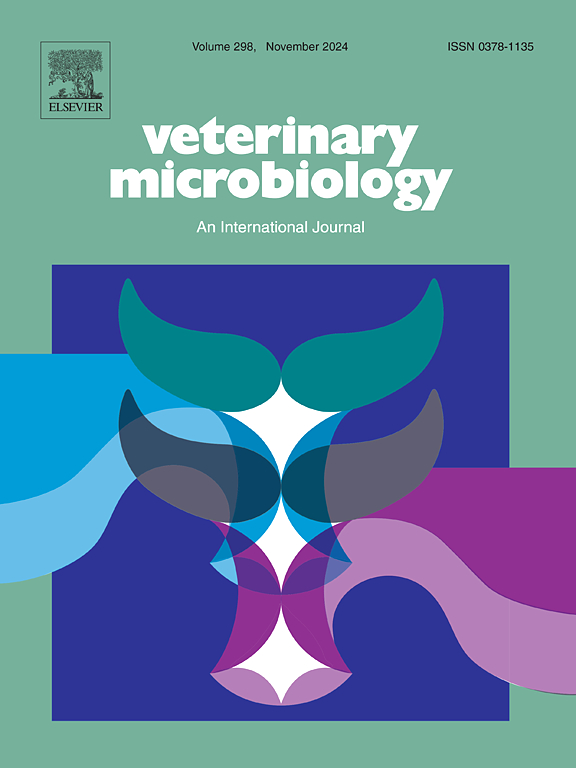Characterization of the immunodominant regions of Senecavirus A-VP1 structural protein via ELISA epitope mapping
IF 2.4
2区 农林科学
Q3 MICROBIOLOGY
引用次数: 0
Abstract
Senecavirus A (SVA) is an RNA virus in the family Picornaviridae that has been detected in swine-production systems and is associated with vesicular disease and neonate mortality. The viral capsid is composed of four structural proteins: VP1–VP4. Although the VP1 protein has been reported to be the most immunogenic protein in vivo, no information on the immunodominant regions of the SVA polyprotein is available. The objective of this study was to identify the immunodominant regions of SVA polyprotein using an enzyme-linked immunosorbent assay (ELISA) epitope-mapping approach. The binding effect of SVA polyclonal antibody (SVA-pAb), SVA-VP1 monoclonal antibodies (SVA-mAb), and SVA-positive sera from clinically affected animals were characterized using a set of 18 overlapping SVA VP1-derived peptides by indirect and blocking ELISAs. All VP1 peptides yielded significant signal against SVA-pAb and SVA-VP1-mAb upon indirect ELISA. One peptide (aa 1–20) showed significantly high optical density on SVA recombinant VP1 protein (rVP1) and whole-virus-based indirect ELISAs. The blocking ELISA results demonstrated that peptides spanning aa 165–185 and 225–245 had a 50 % or greater inhibitory effect on SVA-pAb, while six groups of overlapping peptides spanning aa 1–35, 45–80, 90–140, 150–170, 195–230, and 240–264 and two groups of overlapping peptides spanning aa 1–50 and 60–264 showed a 50 % inhibitory effect or greater on swine VP1-mAb and SVA-seropositive swine serum, respectively, against SVA rVP1. Three-dimensional protein homology modeling showed that the peptides binding SVA-pAb are located on the outer surface of the viral capsid, while SVA mAbs and swine-positive sere can bind to epitopes located in both the inner and outer surfaces of the capsid. These linear epitopes showed differential binding and inhibitory activity on mAb and pAb; however, further studies will be necessary to evaluate whether they can act as decoy or neutralizing epitopes. Because mAb antibodies demonstrated a high binding affinity for this set of peptides, this information could lay the foundation for generating and screening specific antibodies for therapeutic potential.
通过 ELISA 表位图谱确定塞内卡病毒 A-VP1 结构蛋白的免疫优势区。
猪流感病毒 A(SVA)是一种 RNA 病毒,属于 Picornaviridae 科,已在猪生产系统中检测到,与水泡病和新生仔猪死亡有关。病毒外壳由四种结构蛋白组成:VP1-VP4。尽管有报告称 VP1 蛋白是体内免疫原性最强的蛋白,但目前尚无关于 SVA 多聚蛋白免疫优势区的信息。本研究的目的是利用酶联免疫吸附试验(ELISA)表位映射法确定 SVA 多聚蛋白的免疫优势区。通过间接ELISA和阻断ELISA,使用一组18个重叠的SVA VP1衍生肽,鉴定了SVA多克隆抗体(SVA-pAb)、SVA-VP1单克隆抗体(SVA-mAb)和临床患病动物的SVA阳性血清的结合效应。在间接酶联免疫吸附试验中,所有 VP1 肽都能产生针对 SVA-pAb 和 SVA-VP1-mAb 的显著信号。其中一个多肽(aa 1-20)在 SVA 重组 VP1 蛋白(rVP1)和基于全病毒的间接 ELISA 中显示出明显的高光密度。阻断酶联免疫吸附试验结果表明,跨越 aa 165-185 和 225-245 的肽对 SVA-pAb 有 50% 或更大的抑制作用,而跨越 aa 1-35、45-80、90-140、150-170、195-230 和 240-264 的六组重叠肽对 SVA-pAb 有更大的抑制作用、195-230和240-264的六组重叠肽,以及跨越aa 1-50和60-264的两组重叠肽,对猪VP1-mAb和SVA-血清阳性猪血清对SVA rVP1的抑制效果分别为50%或更高。三维蛋白质同源建模显示,与 SVA-pAb 结合的肽位于病毒外壳的外表面,而 SVA mAbs 和猪阳性血清可与位于外壳内表面和外表面的表位结合。这些线性表位在 mAb 和 pAb 上显示出不同的结合和抑制活性;然而,要评估它们是否能作为诱饵或中和表位,还需要进一步的研究。由于 mAb 抗体对这组肽具有很高的结合亲和力,这些信息可为生成和筛选具有治疗潜力的特异性抗体奠定基础。
本文章由计算机程序翻译,如有差异,请以英文原文为准。
求助全文
约1分钟内获得全文
求助全文
来源期刊

Veterinary microbiology
农林科学-兽医学
CiteScore
5.90
自引率
6.10%
发文量
221
审稿时长
52 days
期刊介绍:
Veterinary Microbiology is concerned with microbial (bacterial, fungal, viral) diseases of domesticated vertebrate animals (livestock, companion animals, fur-bearing animals, game, poultry, fish) that supply food, other useful products or companionship. In addition, Microbial diseases of wild animals living in captivity, or as members of the feral fauna will also be considered if the infections are of interest because of their interrelation with humans (zoonoses) and/or domestic animals. Studies of antimicrobial resistance are also included, provided that the results represent a substantial advance in knowledge. Authors are strongly encouraged to read - prior to submission - the Editorials (''Scope or cope'' and ''Scope or cope II'') published previously in the journal. The Editors reserve the right to suggest submission to another journal for those papers which they feel would be more appropriate for consideration by that journal.
Original research papers of high quality and novelty on aspects of control, host response, molecular biology, pathogenesis, prevention, and treatment of microbial diseases of animals are published. Papers dealing primarily with immunology, epidemiology, molecular biology and antiviral or microbial agents will only be considered if they demonstrate a clear impact on a disease. Papers focusing solely on diagnostic techniques (such as another PCR protocol or ELISA) will not be published - focus should be on a microorganism and not on a particular technique. Papers only reporting microbial sequences, transcriptomics data, or proteomics data will not be considered unless the results represent a substantial advance in knowledge.
Drug trial papers will be considered if they have general application or significance. Papers on the identification of microorganisms will also be considered, but detailed taxonomic studies do not fall within the scope of the journal. Case reports will not be published, unless they have general application or contain novel aspects. Papers of geographically limited interest, which repeat what had been established elsewhere will not be considered. The readership of the journal is global.
 求助内容:
求助内容: 应助结果提醒方式:
应助结果提醒方式:


